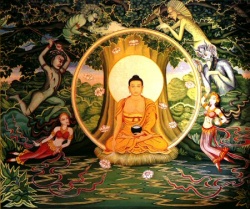Difference between revisions of "Paramārtha-satya"
Jump to navigation
Jump to search
(Created page with "thumb|250px| paramārtha-satya (Sanskrit). Absolute truth or absolute reality. The ultimate level of truth or reality which denotes direct experience de...") |
|||
| Line 1: | Line 1: | ||
[[File:Ma-buddha.jpg|thumb|250px|]] | [[File:Ma-buddha.jpg|thumb|250px|]] | ||
| − | paramārtha-satya (Sanskrit). Absolute | + | paramārtha-satya ([[Sanskrit]]). Absolute [[Truth]] or absolute reality. The ultimate level of [[Truth]] or reality which denotes direct experience devoid of an overlay of conceptualization, and stands in contrast to ‘relative [[Truth]]’ (saṃvṛti-satya). Both terms are used epistemologically as well as ontologically in [[Mahāyāna]] Buddhist [[Thought]]. |
See also Two Truths. | See also Two Truths. | ||
Revision as of 01:19, 30 April 2013
paramārtha-satya (Sanskrit). Absolute Truth or absolute reality. The ultimate level of Truth or reality which denotes direct experience devoid of an overlay of conceptualization, and stands in contrast to ‘relative Truth’ (saṃvṛti-satya). Both terms are used epistemologically as well as ontologically in Mahāyāna Buddhist Thought.
See also Two Truths.
